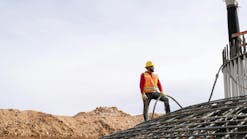As I have watched and participated in the work of our American Society of Civil Engineers (ASCE) committees, I cannot help but make this observation: Commitment, compromise and consensus are alive and well, and being practiced every day. These are the building blocks on which incremental improvements are made and greater things are accomplished. I have watched firsthand as the engineers, scientists, managers and support staff in our industry have committed their time and energy, and put aside their egos and agendas to compromise and build consensus.
- Commitment – Although inundated with work, hundreds of ASCE members year after year make commitments of time, energy, enthusiasm and, yes, even money to support the work of ASCE committees. Most often, these individuals have full-time careers and an active personal life. Thankfully, this commitment is a labor of love as public recognition and thanks rarely follow.
- Compromise – As engineers, we want to share our expertise so others can avoid the pitfalls that shaped our experience. Because much of our experience comes with hard-earned scars, compromise is often difficult to accept, especially if there looks to be a trap for an unsuspecting engineer. However, time after time, small groups of engineers come together to wordsmith passages, create drawings and add additional material such that all points of view are incorporated.
- Consensus – Each of the documents or events produced within ASCE are consensus efforts. They are complete and correct within the abilities of those participating and the time allotted. We should not assume perfection has been achieved when the work has been completed. However, in every case, the bar has been raised.
To achieve consensus and publish a document, committees have had to compassionately consider other points of view. The result enables engineers to complete designs based on a compilation of current best-available information.
There is nothing quite like the satisfaction and sense of accomplishment that you feel when seeing a plan come together or a goal accomplished. Many of our ASCE members will experience this sense of quiet satisfaction over the next six months, as we see several accomplishments coming from their committees. For example, the ASCE/Structural Engineering Institute and steering committee for the Electrical Transmission & Substation Structures (ETS) Conference will host this event in 2018. Held every three years, it is one of the largest and most valuable conferences in our industry. We will be publishing three Manuals of Practice (MoP) as well as one committee paper. These are all fantastic accomplishments—each of them years in the making. Following are brief updates on the five task committees working under the ETS Committee:
- ASCE-141 Wood Pole Structures for Electrical Transmission Lines: Recommended Practice for Design and Use – The development of this document is complete and is scheduled to be published in time for the ETS Conference in November 2018. Expectations are high this MoP will fill gaps and provide consistency in the design of wood transmission structures.
- ASCE-104 Recommended Practice for Fiber-Reinforced Polymer Products for Overhead Utility Line Structures – This MoP is complete and headed to publishing. Much anticipation surrounds this second edition as it captures significant advancements in the understanding, acceptance and use of fiber-reinforced polymer (FRP) products since the 2003 edition.
- ASCE-104 is set to be published in early 2019.
- ASCE-74 Guidelines for Electrical Transmission Line Structural Loading – Frank Agnew, chair of the Task Committee for ASCE-74 MoP, and the editorial subcommittee have addressed comments from the blue-ribbon panel and, in the process, have rewritten two of the chapters substantially. This fourth edition will be submitted for publishing before the end of the year. This latest edition is highly anticipated as it includes a draft pre-standard look at minimum design loads for electrical transmission line facilities. ASCE-74 is set to publish in early 2019.
- Aesthetic Design of Transmission Line Structures – The finishing touches are being put on the committee report with publication expected in early 2019. The report will raise awareness of the role aesthetics can play in the design of transmission line structures.
- ASCE-113 Substation Structure Design Guide – Revisions and updates to the current MoP are continuing with final editing of the base document in progress.
We tend to take the guidelines, codes, recommended practices and standards used every day for granted. We tend to forget without the work and devotion of all the engineers, scientists, managers and support staff in our industry, none of these would happen. Without great fanfare or excessive tweeting, our ASCE committees set a shining example of improvements and accomplishments through commitment, compromise and consensus.
To all of you who participate, it is an honor to be able to say thank you, well done and keep up the good work!
Ronald J. Carrington, P.E., is a project director at POWER Engineers Inc. He is chair of the American Society of Civil Engineers/Structural Engineering Institute Electrical Transmission Structures Committee.


